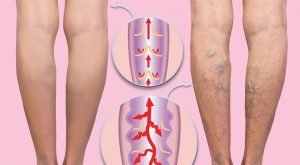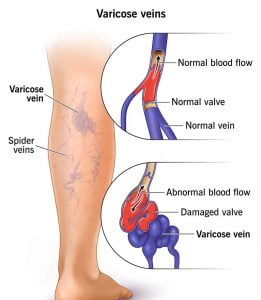Make an Appointment Now
info@macitbitargil.com
Acıbadem Hospitals
Make an Appointment Now
info@macitbitargil.com
Acıbadem Hospitals

In general, the enlargement of the leg veins is called varicose disease. Varicose veins, which is a disease, should be taken seriously and its treatment should not be delayed. Although many patients prefer varicose veins treatment for aesthetic concerns, it should not be forgotten that it is a health problem that should not be neglected in terms of health.
Veins in the body are responsible for providing blood circulation. While the arteries undertake the task of carrying clean blood to the organs and tissues in the body, the task of returning the dirty blood to the heart belongs to the veins.
The valves in the veins prevent the blood from flowing backwards as the blood goes towards the heart. Thanks to the mechanism in the valves, the dirty blood does not flow back. Varicose veins occur as a result of the deterioration of this system, and varicose veins, known as vein enlargement and swelling, are more common in women.
Although varicose veins are generally considered to be an aesthetic problem, the formation of varicose veins should also be evaluated in terms of health, since it means that there is a problem in the veins leading to the heart. Varicose veins should be considered and treated as problems such as slowing of blood flow and damage to organs due to occlusion in the veins may occur.
There are many different causes of varicose veins. It is possible to develop varicose veins due to pregnancy, standing for long periods, obesity, certain occupational groups, wearing tight clothes, old age, constipation, genetic factors, birth control pills and hormone treatments.
In the case of varicose veins caused by the insufficiency of the venous valve, the blood is constantly flowing back and pooling. In this case, pressure increase and swelling occur in the vein. Over time, as the enlargement of the vein increases, curling is seen.
Varicose veins can occur at any level of the vein. In the case of a clot in the vein, the vein expands with the pooling of blood behind the clogged vein and varicose veins may occur.
Varicose veins, which are one of the circulatory system disorders, usually cause similar negative effects, although they occur for different reasons. Individual complaints can negatively affect the patient’s psychological state and quality of life.
Patients usually present to the doctor with the following symptoms:
Complaints are usually minimal in the morning hours. It increases due to standing for a long time or towards evening hours. Exercise and raising the legs can reduce complaints.
Although varicose veins can be caused by different reasons, age increases the risk of varicose veins. The incidence is higher in women. During pregnancy, the susceptibility to varicose development increases.
By affecting the increase in venous blood pressure, obesity paves the way for the formation of varicose veins. Having a body mass index above 30 is another factor that increases the risk of varicose veins. Genetic factors are also important.
Varicose veins usually develop due to venous insufficiency. In healthy individuals, blood flow from the leg veins is from the ankles to the heart. The backward flow of blood in the legs from the top to the bottom causes the venous blood pressure to rise and the formation of varicose veins. There are two main causes of venous insufficiency: valve insufficiency and Deep Vein Thrombosis.
Varicose veins cause complaints such as heaviness or fullness, pain, swelling, itching and night cramps, especially in the calves. When a doctor is consulted in case of such complaints, the patient’s medical history is taken and examined. The diagnosis is made by evaluating the results of leg vein ultrasonography.
Varicose veins is a health problem that can negatively affect an individual’s quality of life and should not be underestimated. Varicose veins can be treated with different methods. At this stage, it is important to determine the method to be applied by making a detailed evaluation for each patient.
The main methods used in the treatment of varicose veins are sclerotherapy, endovenous interventions and surgical treatment. The method to be applied is determined according to the prevalence and size of the varicose.
Sclerotherapy: This method, also known as needle therapy, is more effective in spider web-shaped blue veins or small varicose veins, also known as telangiectasia. The drug is injected into the vein using very fine-tipped needles. In some cases, it may be preferable to use the same drug by turning it into a foam.
Endovenous interventions: Methods such as laser therapy and radiofrequency ablation are considered within this scope. A catheter is inserted into the vein under the guidance of ultrasound, and the varicose veins are contracted through the vein. Laser therapy can be used in this method. The capillaries formed at the skin level can also be destroyed by laser over the skin. It does not cause any interruption in the daily life of the patients.
Surgical intervention: In addition to the removal of externally visible varicose veins, it is applied to eliminate the insufficiency that causes high pressure in the veins and usually caused by the valves in the inguinal region. Doppler ultrasound examination before this procedure is a very important step. It can be preferred for solving the problem between the groin and the knee by using laser or sound wave energy and for regional removal of varicose veins under the knee.
In cases where the patient does not have valve insufficiency, enlarged varicose balls are removed by making small skin incisions on them. Incisions 2 to 3 mm long, parallel to the natural lines of the skin, usually heal on their own without the need for stitches. Thus, there is no scar in the application area after the operation. It is possible to apply under local anesthesia or general anesthesia depending on the multiplicity of side branch varices and the patient’s request.

Depending on the method chosen as the treatment of varicose veins, the healing process and the things to be considered in this process may vary.
Considerations After Sclerotherapy
Compression stockings should not be removed for 48 hours. They should be worn as long as possible in the following days because wearing compression stockings after the session directly affects the success of the treatment.
After the session, 30 minutes of moderate-paced walking should be done, and Turkish bath, sauna and hot bath should be avoided for 3-4 days. The application areas should not be exposed to direct sunlight for 1 month after the treatment. There may be changes in this period according to the recovery period of the skin after the treatment.
Considerations After Intravenous Laser Treatment
After the procedure, the skin is cleaned and compression stockings are worn or an elastic bandage is applied. Compression stockings should be worn from morning to evening in the first week. It is recommended to continue daily activities in order to minimize the risk of clot formation in deep veins after the application.
Mild pain, redness or bruising may be felt for a few days following treatment. Keeping the legs elevated, applying warm compresses and taking simple pain relievers prescribed by the doctor can be effective. Lifting weights, heavy exercises and hot bath, Turkish bath and sauna should be avoided for the first 2 weeks.
It is recommended not to drive for 24 hours after the treatment and not to travel by plane in the first week. Pain, sensitivity to touch, bruising, stiffness and tension may be felt in the application area. Regular taking the drugs prescribed by the doctor can increase the comfort of the patient.
Physical activity should be limited for 24 to 48 hours after treatment. In order to minimize the risk of deep vein clot formation, short walks should be done 2-3 times a day.
Weight should not be lifted for the first 2 weeks, heavy exercises that may cause strain should be avoided. Hot bath and Turkish bath are also not recommended by doctors during this period.
In the first week following the treatment, care should be taken not to stand or sit for long hours. Also, long car and plane trips should not be made during this period.
All content on the website is for informational purposes only. Consult your doctor for diagnosis and treatment methods.
2022 © All Rights reserved | Design & SEO & Development Simur Digital